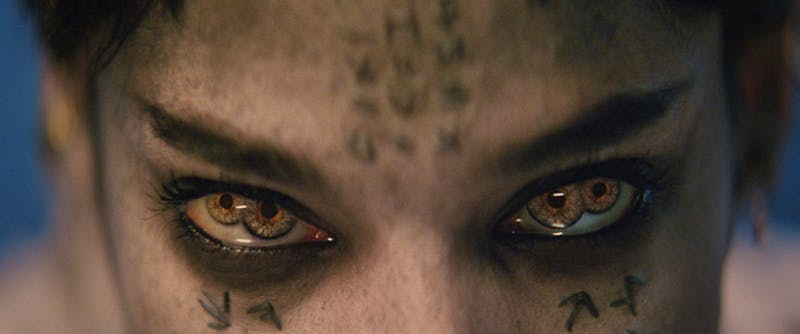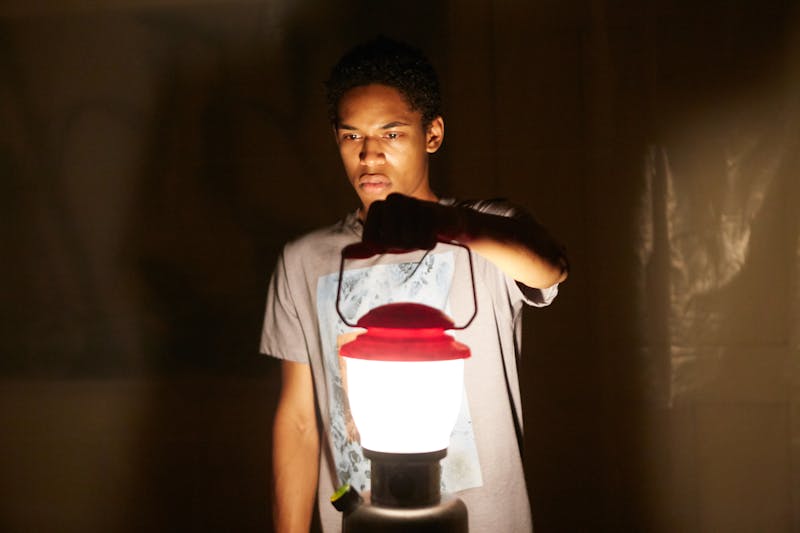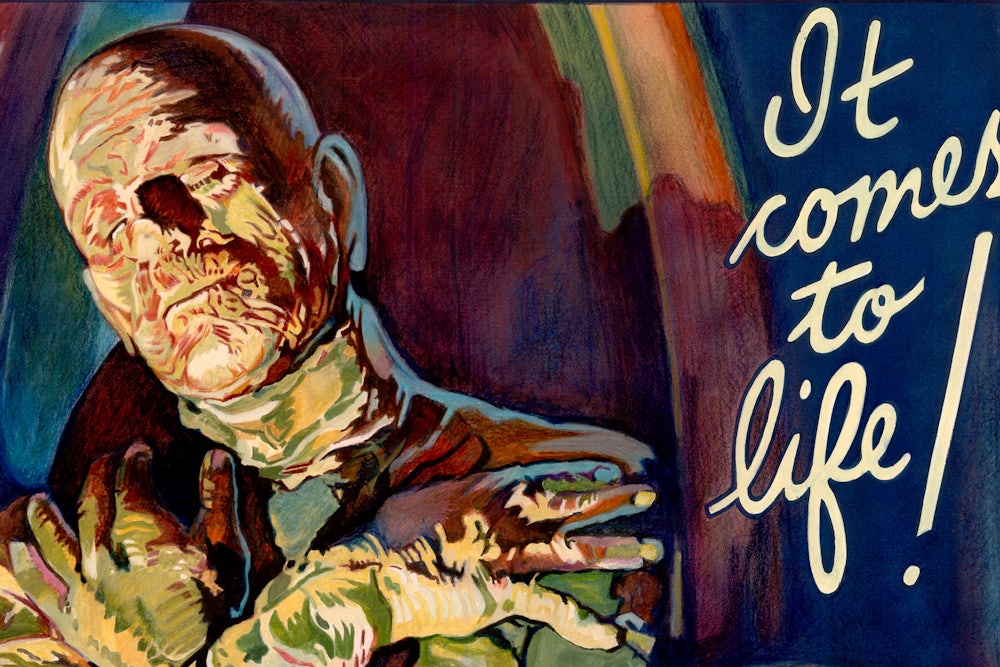Summer is for scary movies. Everybody stays up late and the night is full of noises. In the heat the city shimmers with tension, in the countryside animals seem to be up all night, watching. Two movies attempt to offer up blockbuster shivers this summer: the latest installment of The Mummy franchise and the much-hyped contagion thriller It Comes at Night. Both movies connect to venerable movie-making traditions, invoking classics of American horror.
Considering that this is the 14th movie about an undead Egyptian person, perhaps the new Tom Cruise picture should have been called A Mummy. Instead, it is the fourth movie to be titled The Mummy, after The Mummy (1932), The Mummy (1959), and The Mummy (1999). Unlike any of its predecessors, this Mummy is set in Iraq and England. (It is also the first in the “Dark Universe” series of Universal monster movies, which I predict will outlive us all.)
The premise for the relocation to Iraq is that the villainous Princess Ahmanet (Sofia Boutella) was so naughty that she had to be dragged far from home for interment. Then, British crusaders carried off her favorite jewel and knife before settling under the Thames. The triad of Cruise’s American protagonist, skirmishes in Iraq, and London action scenes thus makes for a horribly parodic sketch of the alliance against the Axis of Evil, although this time the generalized, brown-skinned enemy has risen from the dead.

The Mummy stars a millennia-old lobotomized hottie with mystical powers, and a mummy. I’m kidding, but at 54, Tom Cruise looks and acts like an embalmed version of himself in the first Mission: Impossible movie. He opens the film by dodging “insurgents” and “ordering an airstrike” on an Iraqi village that presumably has been dragged into the American war. The 1999 version of The Mummy similarly opened with warfare, but that was a colonial fantasy from 1920s Egypt. Equally horrible, of course, but at least not about people who are dying now.
This new The Mummy has some excellent action scenes, particularly when our undead heroine (who remains sexy despite partial decomposition and having four eyes) summons all the glass in London to explode into sand. Unfortunately, neither Tom Cruise nor his co-star Annabelle Wallis are anywhere near as funny as Brendan Fraser and Rachel Weisz were in the 1999 classic. That mummy was funny, too—remember how he was afraid of cats? Cruise at least gets some good lines in, but Wallis is essentially a blonde plank with a face drawn on it, occasionally breathing the phrase, “Oh my god.”
To be fair to director Alex Kurtzman, he has a long tradition to contend with. The 1932 The Mummy, starring Boris Karloff, was a Karl Freund joint. The plot is remarkably similar to the 1999 version: A sinning priest named Imhotep accidentally gets resurrected, and he’s looking for his girlfriend. But the interesting difference is that Imhotep in the 1932 world has been masquerading as a regular guy. The horror hinges on not knowing whether the mummy is dead or alive. He presents a category problem, bringing a strange and unholy presence to the screen.
The mummy’s physical repulsiveness is crucial to the 1932 version, and then every mummy-centric picture since, until now. Sofia Boutella brings a gorgeous intensity to her role, but there’s none of the scarab-chewing grossness of Arnold Vosloo’s mummy in 1999, or the looming menace of Karloff, or the grodily flaking flesh of Christopher Lee in 1959.
This mummy has trendy bangs. There’s a thrill to be had in her feminine power, not least when she sucks the life out of men by kissing them (at last, a truly feminist action hero!). But by removing the grossness from the movie, The Mummy loses some of its purpose.
It Comes at Night is grotesquely misadvertised. The trailer shows black-eyed demons puking into people’s mouths, while the title implies some marauding monster. In reality, It Comes at Night is a movie about a highly infectious disease: A family is camped out in a house in the woods, escaping a contagion that is destroying society. A new family comes along. Should they be trusted, or not?
It’s an interesting premise, and It Comes at Night blends a remarkable number of traditions. There’s the family-as-microcosm thing, hearkening back to those isolated rural families of Chekhov, while the boarded-up-house-plus-contagion-fear recalls Night of the Living Dead. The woods have a menace that matches The Blair Witch Project. And the terrible prospect of losing loved ones to disease most closely matches 28 Days Later.

It Comes at Night makes a number of striking moves with genre. It will also be remembered as the breakout role for Kelvin Harrison Jr., who you may recall from The Birth of a Nation. As the teenage son Travis, his perspective holds the movie together. Harrison’s embodiment of teenage fear is excruciating to watch. He speaks little, communicating with his parents through tear-filled stares and keeping his eyes down when talking to strangers. He acts his adolescence with his whole body.
The character of Travis also develops the movie’s most interesting theme around physical intimacy. He eavesdrops on others’ breathy, nighttime conversations. We hear his breath inside his gask mask, see him in bed, enter his dreams. The house is filled with intimacies that make its inhabitants feel soft and vulnerable. The fear that haunts the house therefore feels like a commentary on the terrible emotional danger of cohabitation and family units, as much as on mistrust.
It Comes at Night is a valuable meditation on what becomes of people when they become desperate. But it isn’t the frightfest that its trailer so strongly implies. In the theater, I heard a baffled “What the fuck?” from a few rows back as the credits rolled.
In fact, neither of the two supposedly frightening movies that opened this past weekend are actually frightening at all. Each feels too concerned with engaging with or rejecting the classic tropes of horror movie-making. It Comes at Night teases with a conventionally bloody trailer, then offers its audience a product overloaded by cinema history and without enough new to offer. The Mummy tries to get out of its own box, but remains mired in the legacy of the 1999 version, which after all is only just old enough to vote.
It is hard to make scary movies in in the 21st century, and a studio might be forgiven for investing in dumb Michael Bay robo-violence instead of even trying to make a new kind of monster. Genre will always loom with a big shadow over any movie attempting to make us jump. But as psychologically innovative pictures like The Conjuring or The Babadook should remind us, it is worth at least trying to do something new, instead of clumsily defanging something old.
